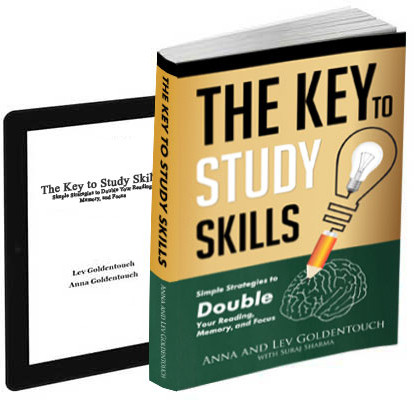We are strong proponents of pre-reading, yet the issue is only briefly mentioned in our course. There is a good reason for it. There is no one good prereading strategy, but several recommended strategies for various scenarios. Instead of discussing various pros and cons I will describe “a day in my life”. My days are …
KeyToStudy Offers:
Memory, Speedreading, and Analysis
KeyToStudy Overview:
Memory, Speedreading, and Analysis
ProlificFocus Overview:
Productivity, Motivation, and Projects
ProlificFocus Offers:
Productivity, Motivation, and Projects
Learning to forgive and forget
We spend most of our time teaching people how to remember stuff. Occasionally students do not want to remember, but instead they want to forget. Many (all?) of us have dramatic or unpleasant experiences in our life that shape us as people and hunt us in our dreams. More often than not during our life …
High level visualization: Gaming and mental templates
I am using my own version of loci method I call “high-level visualization”, which is more of a game than a house. I have wrote several articles about this before. Here I address this method from a different angle. The loci method enables accurate memorization of huge amount of information. Most of memory champions use …
Continue reading “High level visualization: Gaming and mental templates”
Visualizing numbers
Many of our students go blank when viewing numbers, tables and formulas. Some they have necessary skills to understand the math, but cannot make it vivid enough. Here I address this and additional reasons. Short numbers. The simplest sort of a problem with numbers is a lack of interest. For me it is hard to remember …
Superlearner story: Marina
The stories of various people we teach may prove interesting to you. While we change the names, most of other facts are true. Probably some of you will recognize some of the people behind the stories. We ask you not to disclose their identity. The first superlearner whom we can tell about we will call …
Getting stuck with visualization
About 1% of our students get stuck with visualization. They either cannot get into the visualization mode and see pitch black, or they cannot get out of visualization mode and experience vivid hallucinations. In both cases, they need to address this course creatively. If you have trouble getting into visualization, this may mean that your …
10 tips for speedreading
Jonathan is planning to publish several speedreading tips in lifehacker.uk. While we are waiting patiently for approval, here are alternative tips by yours truly. Knowledge is intoxicating. Knowledge feeds our imagination, give us mental strength and resilience, fuels modern technology and economy – it is a key component of making us truly human (and possibly …
Innovation vs persistence
There is a trade-off between innovation and persistence that I see in my recent work. The innovation comes in form of new exciting opportunities. Out of the blue [there is actually a lot of work and planning around it, I will describe in separate posts] I generate interesting ideas, or I am approached by exciting …
Generating habits out of hacks
Is superlearning a collection of hacks or a new life habit? Both, actually. We explain one hack after another like steps of a ladder leading to a totally new learning experience. Being able to enjoy the new learning experience requires certain learning habits or a certain lifestyle choice. I have been collecting articles about building …
Healthy lifestyle
Occasionally we discuss various aspects of healthy lifestyle and try to generate a list of simple advices. This post is once again addressing this subject from a different angle. Below there are several ways to transform bad habits into good habits. Effects of lifestyle Your lifestyle may boost your brainpower or hurt your memory. The …

